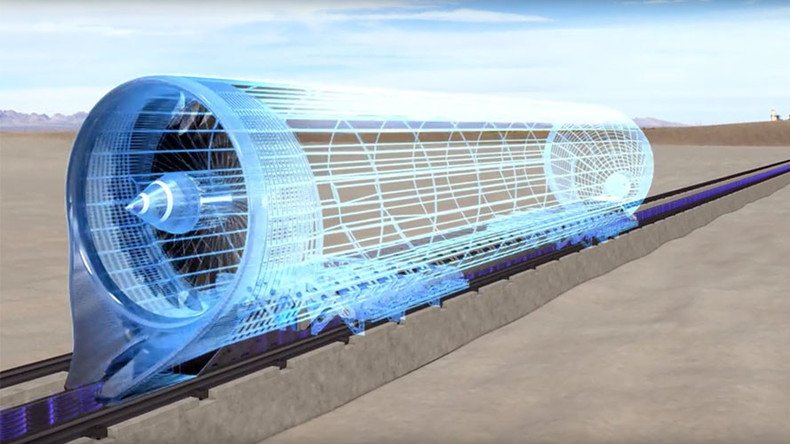Hyperloop’s 1st-ever track test a success in Las Vegas (NEW VIDEO)

Humans are about to enter a new era of epic high-speed travel, according to those behind the first-ever track test of a pneumatic ground propulsion system dubbed ‘Hyperloop,’ which has just completed a successful test run in North Las Vegas.
WATCH! Test successful! #hyperloop#8NNpic.twitter.com/sN7uFxmGQe
— Patrick Walker (@PatrickWalker) May 11, 2016
Based on an idea by billionaire Elon Musk in 2013, the open-source technology being developed by a number of companies, university students, and independent engineers hopes to transport people and goods in capsules through a global network of tubes at speeds up to 800mph (1280kph).
Hyperloop deal would link three European capitals https://t.co/6q54BJkghp#Europepic.twitter.com/tlQedpmsYH
— Peter Struikman (@PeterStruikman) April 29, 2016
Hyperloop One took the lead by raising US$80 million in Series B financing, enough to build a test track in an industrial estate in the suburbs of Sin City.
Engineers sent motors down a half-mile track at speeds of up to 330mph in the first of its POATs (propulsion open air tests), which the start-up says will “lay the groundwork for the world’s next defining milestone.”
Hyperloop One takes its cue from the "very sucky" tubes used by drive-through banks, supermarkets, and the 2003 film "Elf" to transport cash and letters in a small capsule.
Using extremely low air pressure, the human-sized tubes can potentially move people in pods from Los Angeles to San Francisco in just 35 minutes, a trip that currently takes an hour by plane, five and a half hours driving, seven hours by bus, and 12 hours via train.
AECOM, the construction firm working on Musk’s SpaceX project, built the test track in North Las Vegas away from the busy ‘Strip,’ just in case it didn't go according to plan.
Early investors in Hyperloop One include the French high-speed rail company SNCF and a General Electrics venture capital subsidiary.
It also created partnerships with companies who want to develop hyperloop links between Stockholm and Helsinki, London and Birmingham, and the Port of Long Beach with the rest of Los Angeles in an effort to ease the city’s traffic congestion.
The company also announced it is changing its name this week from the previous Hyperloop Technologies in an effort to differentiate themselves from Hyperloop Transportation Technologies, a rival startup aiming to start testing in 2018.
The latter venture licensed its ‘passive magnetic levitation technology,’ which floats the train above the track on magnets as opposed to Hyperloop One’s compressed air skis.
No word on when you can embrace your inner Mario by jumping into a tube in London and coming out in Sydney, but for now we have clips of Hyperloop One’s first test run.
Hyperloop first test!! pic.twitter.com/gnVowvS6Gk
— Ruth Reader (@RuthReader) May 11, 2016












